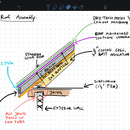Metal roof over polyiso, conditioned attic in Zone 5
Hi,
Attached is a picture of the proposed assembly.
We’re working on a farmhouse from the 1850s in Zone 5A. The house had originally no insulation and no roof decking, except at the perimeter, and most likely a metal roof installed on battens. At some point, the attic was insulated with fiberglass batts and 3/4″ board roof decking and asphalt shingles installed. The extra weight and inadequate ventilation resulted in a partly rotted roof and rafters deflected to L/50.
The plans call for a conditioned attic, skylights in the bathroom and a cathedral ceiling in the bedroom, i.e. some challenges to get this right. The structural engineer suggested this would be a good time to bring the roof structure up to code, so new rafters are being installed.
I’m concerned about thermal bridging through the rafters, so was hoping to install continuous insulation above the roof decking. The depth of the continuous insulation is limited to 2″ to avoid changing the trim and instead just cover it with a long drip edge. The R15 from the polyiso is insufficient to bring the sheathing above the dew point here in zone 5 – hence closed cell foam in the rafter bays.
Some questions for the building science experts:
(1) Does this assembly make sense?
(2) Should I install another membrane between the deck and the poly iso? My inclination is not to do this, as the closed cell foam is an air barrier anyways. If water gets there, it’ll cause long-term issues with or without the extra layer.
(3) What are the thoughts on the dry-tech air-gap membrane under the roofing? I don’t see any benefit in terms of condensation or ventilation, but does the extra space help to meaningfully protect the synthetic underlay from damage from the high temperature? Battens are not an acceptable substrate as per the metal roof manufacturer.
(4) I have access to both Kraft-Fiberglass covered and foil faced polyiso. Any reason to install the foil faced one?
Thank you!
Juli
GBA Detail Library
A collection of one thousand construction details organized by climate and house part










Replies
Your assembly will work, but you can probably get away with less closed cell foam bellow the rafters.
Most codes allow for insulation compliance based on the performance of the whole assembly, with continuous rigid foam above, this generally means less center of cavity R value. For example, our code requires R31, but can go down to R27 effective assembly. If you are in R49 land, it would be an R38 assembly.
In case of 2" polyiso above, you In Zone 5, you need 40% of your assembly R value foam. To hit an R38 assembly, you can go with 1.5" of cc SPF and R19 batts.
The breather under the metal roof will not do much. The gap provided is not sufficient for any appreciable airflow and the capillary break it provides is not needed with metal roofing.
Make sure your metal panels can be installed directly over rigid insulation, most need either 1x4 battens or plywood above the foam.
The foam can have any type of facing. Typically I go with fiber faced as it the common stock item at roofing supplies. Just make sure it stays dry until the underlayment goes up as it tends to warp if it gets wet.
Hi Akos!
Thank you for your response. What thickness of closed cell foam is sufficient as a vapor barrier for a conditioned attic?
Juli
Generally 2" SPF is sufficient vapor barrier for the even the coldest of climates.
The 1.5" I suggest above falls slightly bellow the definition of vapour barrier of my local code but it close enough that it will work especially with the extra insulation above the deck.
When it comes to roofs, the most important item is sufficient rigid insulation (40% ratio above) for condensation control and air sealing which the cc SPF does an excellent job of.